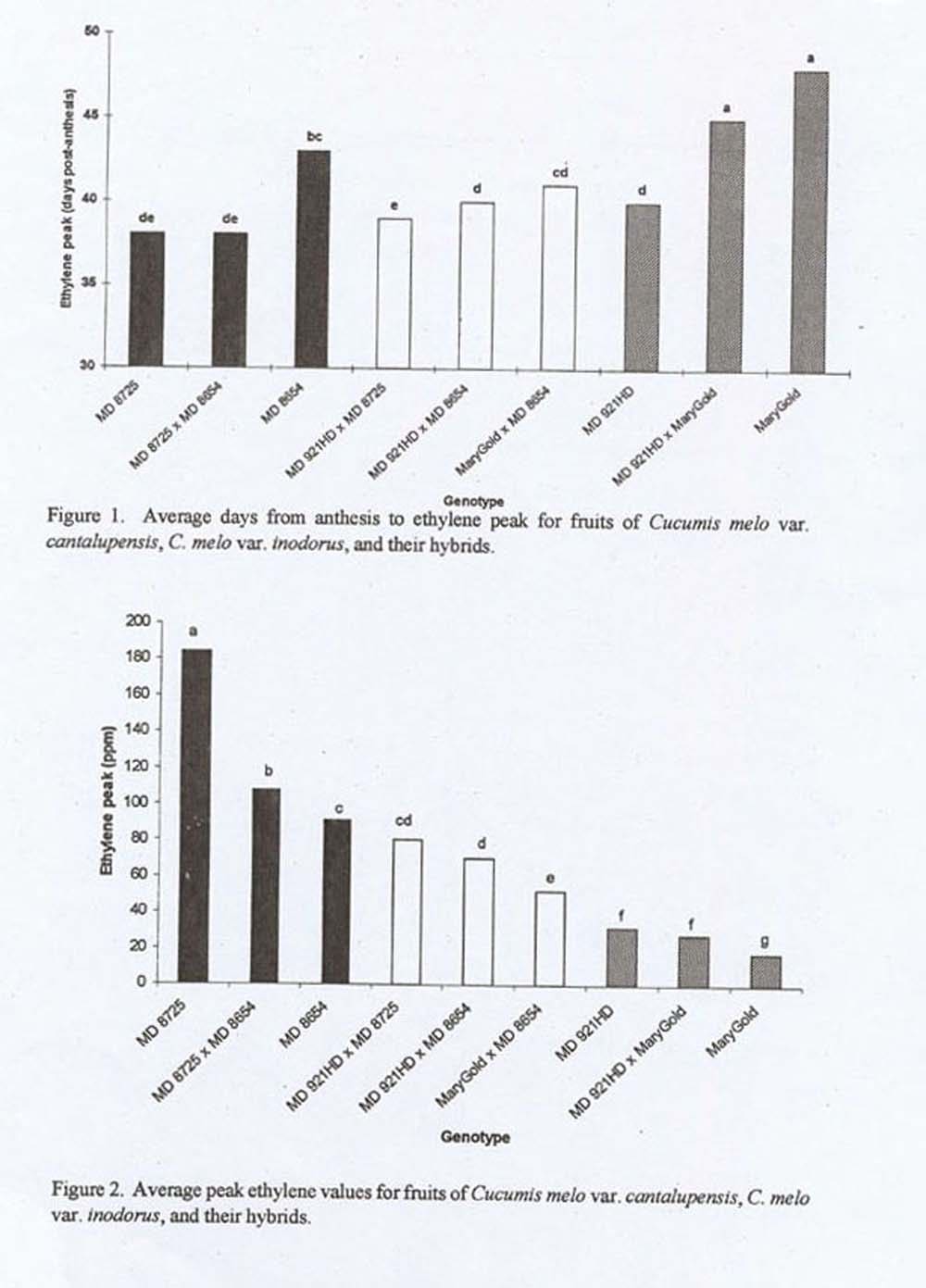Cucurbit Genetics Cooperative Report 21:31-32 (article11) 1998
Bin Wang and Timothy J. Ng
Dept. Natural Resource Sciences, University of Maryland, College Park, Maryland 20742-4452 USA
Introduction. Melon (Cucumis melo L.) is a polymorphic species with regard to fruit characteristics, exhibiting diversity for shape, external and internal color, surface netting, sweetness, flavor, ripening pattern and storability. Fruits of the cantalupensis subspecies of melon typically exhibit a climacteric rise in ethylene and carbon dioxide production during ripening, while inodorus fruits produce little or no detectable ethylene as they approach maturity (Kendall and Ng, 1988; Wolff and Dunlap, 1995). The objective of the current study was to investigate ethylene production in fruits from crosses between cantalupensis and inodorus melons.
Materials and Methods. Two cantalupensis genotypes (MD 8725 and MD 8654) and two inodorus genotypes MD 921HD and ‘MaryGold’) were used. Both MD 8725 and MD 8654 were netted, orange-fleshed cultigens, while MD 921HD was a green-fleshed honeydew and ‘MaryGold’ was a white-fleshed casaba. The cantalupensis lines abscised at fruit maturity and exhibited a short storage life, while the inodorus lines ripened slowly and failed to develop a distinct abscission layer.
F1 hybrid seeds were obtained through controlled pollinations in the winter of 1995 in the greenhouse. Five hybrids were obtained: (1) MD 921HD x MaryGold’, (2) MD 8725 x MD 8654, (3) MD 921HD x MD 8725, (4) MD 921HD x MD 8654, and (5) ‘MaryGold’ x MD 8654, Seeds were sown in a greenhouse nd transplanted to the field on 30 June 1996. Plants were spaced 1.8 m within the row, and 1.9 m between rows. The experimental design was a RCB with three replications, each replicate consisting of four plants.
When fruits were ca. 25 days old (25 days post-anthesis), they were surface sterilized, and a sterilized stainless steel needle (12 gauge) fitted with a rubber septum cap was inserted into the cavity and secured to the rind with cyanocrylate ester glue. This allowed repetitive sampling of internal ethylene, beginning when the fruits were ca. 27 days old and still pre-climacteric. A 1 ml gas sample was extracted from each fruit at 9 a.m. each day, then analyzed by gas chromatography (Hewlet-Packard 5830A). fruits which were abscised at maturity were maintained in the field with additional sampling.
Results and Discussion. There were significant differences in ethylene peak day among the different genotypes (Figure 1). The earliest peak days (38-39 days) were exhibited by MD 8725 and its hybrids with MD 8654 and MD 921HD. ‘MaryGold’ had the longest period to peak ethylene production at 48 days. The MD 921HD x ‘MaryGold’ F1 had the second longest period, at a value midway between the two parents.
Peak ethylene values for the nine cultigens are illustrated in figure 2. On the average, the ethylene peak of the cantalupensis lines was 6 times that of the inodorus lines (137 ppm vs. 23 ppm). Ethylene peak values between the subspecies was intermediate at 66 ppm. The ethylene peak of MD 8725 (184 ppm) was twice that of MD 8654 (90 ppm), while the ethylene peaks of MD 921HD and ‘MaryGold’ were 30 ppm and 15 ppm, respectively.
Based on these and other characteristics measured (data not shown), fruits of the cantalupensis lines reached the onset of the climacteric and initiated ripening earlier than the inodorus lines. They ripened and abscised rapidly and were highly perishable, whereas the inodorus fruits ripened slowly and could be stored for a longer time. The peak value of ethylene production appeared to be the most useful index for determining storage life of the cultigens and their hybrids.
Figure 1. Average days from anthesis to ethylene peak for fruits of Cucumis melo Var. Cantalupensis, C. melo var. inodorus, and their hybrids. and Figure 2. Average peak ethylene values for fruits of Cucumis melo var. cantalupensis, C. melo var. inodorus, and their hybrids.

Literature Cited
- Kendall, S.A. and T.J. Ng. 1988. Genetic variation of ethylene production in harvested muskmelon fruits. HortScience 23:759-761.
- Wolff, D.W. and J.R. Dunlap. 1995. Ethylene production rate and postharvest shelf-life of melons with diverse ripening phenotypes. IN: J. Dunlap and G. Lester (eds.). Cucurbitaceae ’94: Evaluation and enhancement of cucurbit germplasm. Gateway Printing and Office Supply, Inc. Edinburg TX.